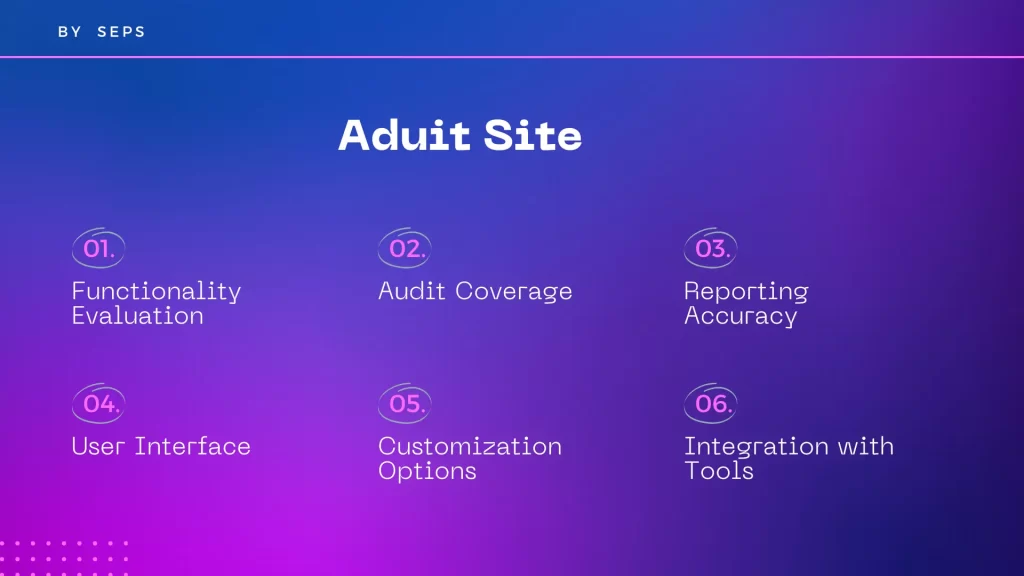Aduit Site
When it comes to auditing websites, ensuring everything is in optimal shape is crucial for maintaining performance and user experience. An audit site process involves a comprehensive review of various aspects like content quality, technical SEO, user interface, and security measures. This thorough assessment helps uncover any issues that may be hindering the site’s performance or user engagement. It ensures that your website not only meets but exceeds industry standards and user expectations.
A well-executed audit site can identify opportunities for improvement, such as optimizing load times, enhancing mobile responsiveness, or fixing broken links. By addressing these issues promptly, you can enhance your site’s search engine rankings and user satisfaction. Moreover, a thorough audit demonstrates your commitment to providing a seamless online experience, which can instill trust and credibility among your audience. Whether you’re looking to boost organic traffic or enhance conversions, a regular audit site is essential for staying ahead in the digital landscape.
Introduction to Audit Site
In today’s digital landscape, where an online presence is crucial for businesses, ensuring the health and performance of a website is paramount. This article delves into the realm of website audits, shedding light on their significance and the various aspects they encompass.
The Importance of Auditing Websites
A website audit, often referred to as an “aduit site,” is the process of analyzing and evaluating a website’s performance, security, SEO factors, and overall functionality. Businesses invest in website audits to identify areas of improvement, rectify issues, and enhance user experience. Neglecting website audits can lead to decreased visibility, poor user engagement, and potential security vulnerabilities.

Types of Website Audits
Website audits can be categorized into various types, each focusing on specific aspects of a website’s performance and functionality.
3.1 Technical Audit
A technical audit assesses the backend infrastructure of a website, including server performance, site speed, and coding issues. It ensures that the website operates smoothly and efficiently.
3.2 SEO Audit
An SEO audit examines the website’s visibility and ranking on search engine results pages (SERPs). It analyzes on-page and off-page factors, keyword optimization, and backlink profiles to improve search engine rankings.
3.3 Content Audit
A content audit evaluates the quality, relevance, and effectiveness of the website’s content. It identifies outdated content, duplicates, and areas for content optimization to enhance user engagement and SEO performance.
3.4 Security Audit
A security audit focuses on identifying vulnerabilities and threats to the website’s security. It includes scanning for malware, assessing encryption protocols, and ensuring compliance with security standards to protect user data and maintain trust.
Key Components of Website Audits
Website audits encompass various components that collectively contribute to the overall health and performance of a website.
4.1 Performance Analysis
Performance analysis evaluates the website’s loading speed, page responsiveness, and overall user experience. It aims to optimize performance for faster loading times and improved user satisfaction.
4.2 Accessibility Check
Accessibility checks ensure that the website is inclusive and accessible to users with disabilities. It involves assessing compatibility with assistive technologies and adhering to accessibility standards such as WCAG (Web Content Accessibility Guidelines).
4.3 Mobile Responsiveness
With the increasing use of mobile devices, ensuring mobile responsiveness is crucial. This component of the audit assesses the website’s compatibility and functionality across different devices and screen sizes.
4.4 Backlink Analysis
Backlink analysis examines the quality and quantity of inbound links pointing to the website. It helps in understanding the website’s authority and improving its search engine ranking.
The Process of Conducting a Website Audit
Conducting a website audit involves a systematic process encompassing preparation, execution, analysis, and reporting.
5.1 Preparation Phase
In the preparation phase, audit objectives are defined, and necessary tools and resources are gathered. This phase also includes setting benchmarks and goals for the audit.
5.2 Audit Execution
During the audit execution phase, the website is systematically analyzed based on the chosen audit parameters. Data is collected, and various tests and assessments are conducted to evaluate different aspects of the website.
5.3 Analysis and Reporting
Following the audit, collected data is analyzed, and findings are compiled into a comprehensive report. The report highlights areas of improvement, actionable insights, and recommendations for optimizing website performance.
6. Tools for Conducting Website Audits
Several tools are available to streamline the process of conducting website audits and gather relevant data efficiently.
6.1 Google Analytics
Google Analytics provides valuable insights into website traffic, user behavior, and conversion rates. It helps in understanding audience demographics, tracking key performance metrics, and identifying areas for improvement.
6.2 SEMrush
SEMrush offers a suite of tools for keyword research, competitor analysis, and SEO auditing. It provides valuable data on keyword rankings, backlink profiles, and site audits to optimize website performance.
6.3 Moz Pro
Moz Pro offers comprehensive SEO tools for keyword research, link building, and site audits. Its features include site crawl, rank tracking, and on-page optimization recommendations to improve search engine visibility.
6.4 Ahrefs
Ahrefs is a powerful SEO toolset that provides insights into backlink analysis, keyword research, and content optimization. It helps in identifying link building opportunities, analyzing competitor strategies, and monitoring website performance.
Benefits of Regular Website Audits
Regular website audits offer numerous benefits for businesses, including:
- Improved website performance and user experience
- Higher search engine rankings and visibility
- Enhanced security and protection against cyber threats
- Better alignment with industry standards and best practices
- Increased website traffic and conversion rates
| Metric | Description |
|---|---|
| Page Loading Speed | The time taken for web pages to load fully, measured in seconds. |
| Mobile Responsiveness | Evaluation of how well the website adapts to different screen sizes and devices. |
| SEO Score | A numerical assessment of the website’s search engine optimization effectiveness. |
| Broken Links | Number of hyperlinks on the website that lead to non-existent or error pages. |
| Security Vulnerabilities | Identified weaknesses or gaps in the website’s security protocols. |
| Backlink Quality | Assessment of the authority and relevance of inbound links pointing to the website. |
| Content Relevance | Evaluation of how well the website’s content aligns with user search intent and relevance. |
| Accessibility Compliance | Adherence to accessibility standards such as WCAG for users with disabilities. |
| Conversion Rate | Percentage of website visitors who complete a desired action, such as making a purchase. |
| Bounce Rate | Percentage of visitors who navigate away from the website after viewing only one page. |
